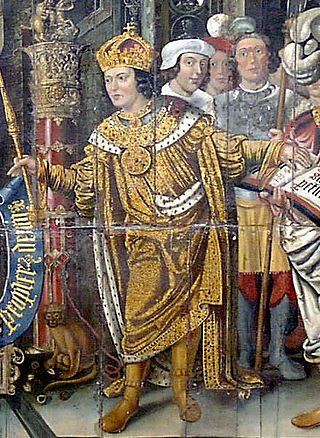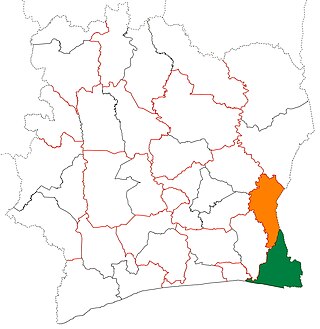Human arrival in Ivory Coast has been dated to the Upper Paleolithic period, or at the minimum, the Neolithic period based on weapon and tool fragments, specifically polished shale axes and remnants of cooking and fishing. The earliest known inhabitants of Côte d'Ivoire left traces scattered throughout the territory. Historians believe these people were all either displaced or absorbed by the ancestors of the present inhabitants. Peoples who arrived before the 16th century include the Ehotilé (Aboisso), Kotrowou (Fresco), Zéhiri, Ega, and Diès (Divo).

The House of Bourbon is a dynasty that originated in the Kingdom of France and is a branch of the Capetian dynasty, the royal House of France. Bourbon kings first ruled France and Navarre in the 16th century, and by the 18th century, members of the Spanish Bourbon dynasty held thrones in Spain, Naples, Sicily, and Parma. Today Spain and Luxembourg have monarchs of the House of Bourbon. The royal Bourbons originated in 1272, when Robert, the youngest son of King Louis IX of France, married the heiress of the lordship of Bourbon. The house continued for three centuries as a cadet branch, serving as nobles under the direct Capetian and Valois kings.

Ivory Coast, officially the Republic of Côte d'Ivoire, also known as Côte d'Ivoire, is a country on the southern coast of West Africa. Its capital city of Yamoussoukro is located in the centre of the country, while its largest city and economic centre is the port city of Abidjan. It borders Guinea to the northwest, Liberia to the west, Mali to the northwest, Burkina Faso to the northeast, Ghana to the east, and the Gulf of Guinea to the south. With 30.9 million inhabitants in 2023, Ivory Coast is the third-most populous country in West Africa. Its official language is French, and indigenous languages are also widely used, including Bété, Baoulé, Dioula, Dan, Anyin, and Cebaara Senufo. In total, there are around 78 different languages spoken in Ivory Coast. The country has a religiously diverse population, including numerous followers of Islam, Christianity, and traditional faiths like Animism.

The King of Romania or King of the Romanians was the title of the monarch of the Kingdom of Romania from 1881 until 1947, when the Romanian Workers' Party proclaimed the Romanian People's Republic following Michael I's forced abdication.

Cædwalla was the King of Wessex from approximately 685 until he abdicated in 688. His name is derived from the Welsh Cadwallon. He was exiled from Wessex as a youth and during this period gathered forces and attacked the South Saxons, killing their king, Æthelwealh, in what is now Sussex. Cædwalla was unable to hold the South Saxon territory, however, and was driven out by Æthelwealh's ealdormen. In either 685 or 686, he became King of Wessex. He may have been involved in suppressing rival dynasties at this time, as an early source records that Wessex was ruled by underkings until Cædwalla.
The diverse culture of Ivory Coast, a coastal West African country bordered by Ghana, Liberia, Mali, Burkina Faso, and Guinea, is exemplified by a multitude of ethnic groups, events, festivals, music, and art.

Sud-Comoé Region is one of the 31 regions of Ivory Coast. Since 2011, it has been one of two regions in Comoé District. The region's seat is Aboisso. The region's area is 7,240 km², and its population in the 2021 census was 784,893.
Abengourou is a city in eastern Côte d'Ivoire. It is the seat of both Comoé District and Indénié-Djuablin Region. It is also a commune and the seat of and a sub-prefecture of Abengourou Department.

Aboisso is a town in south-eastern Ivory Coast lying on the Soumié River. It is a sub-prefecture of the Aboisso Department for which it is also the seat of government. Aboisso is also a commune as well as the seat of government for the Sud-Comoé Region in Comoé District.

The monarchy of Denmark is a constitutional institution and a historic office of the Kingdom of Denmark. The Kingdom includes Denmark proper and the autonomous territories of the Faroe Islands and Greenland. The Kingdom of Denmark was already consolidated in the 8th century, whose rulers are consistently referred to in Frankish sources as "kings". Under the rule of King Gudfred in 804 the Kingdom may have included all the major provinces of medieval Denmark.
Assinie-Mafia is a coastal resort town in south-eastern Ivory Coast. It is a sub-prefecture of Adiaké Department in Sud-Comoé Region, Comoé District.
Krindjabo is a village in south-eastern Ivory Coast. It is in the sub-prefecture of Aboisso, Aboisso Department, Sud-Comoé Region, Comoé District.

Parakramabahu II, also known as Panditha Parakramabāhu, was the King of Dambadeniya in 13th century, whose reign lasted from 1236 to 1270. As a pioneer in literature, he was bestowed with the honorary title "Kalikala Sahitya Sarvagna Pandita". Parakramabahu's reign is notable for the creation of numerous Sinhalese literal works such as, Kausilumina, Pūjāvaliya, Pāli Vishuddḥi Mārgaya, Thūpavaṃsa and Sidhath Sangarāva. He launched a campaign against the Eastern Ganga invader Kalinga Magha, and successfully expelled him in 1255, unifying Sri Lanka under one rule. He succeeded his father Vijayabahu III as King of Dambadeniya, and was succeeded by his elder son, Vijayabahu IV, after his death.
The Evangelical Presbyterian Church of Ivory Coast is a confessional Presbyterian denomination in Ivory Coast.

Moronou Region is one of the 31 regions of Ivory Coast. Since its creation in 2012, it has been one of four regions in Lacs District. The seat of the region is Bongouanou and the region's population in the 2021 census was 439,755.

Marcel Amon-Tanoh is an Ivorian politician.

Amon N'Douffou V is king of the Kingdom of Sanwi in Ivory Coast, Africa. He was enthroned August 5, 2005, which was reported by AllAfrica.com to result in "popular jubilation". The coronation, held in Krinjabo, took three days.
Emile Eugène André Dervain (1928–2010) was a Martinican-Ivorian playwright, lawyer and judge.











